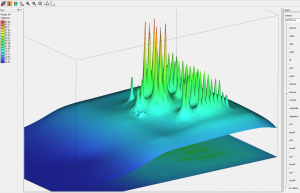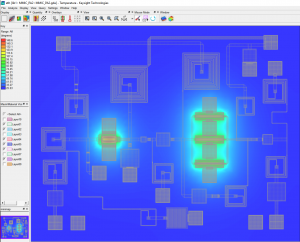As wireless devices increase in complexity, the challenges around maintaining temperature control continue to mount. As smartphones, for example, require more and more transistors to fit into smaller spaces, there’s simply not as much space for the heat to dissipate. Wireless designers are tasked with finding new ways to keep these devices from overheating without compromising the compact design that consumers crave. Meanwhile, wireless charging, which was included in more than 250 million devices in 2016, is expected to reach $66.57 billion by 2027, according to Inkwood Research. Yet wireless devices’ innovative designs and advanced capabilities often come with overheating challenges. To avoid these common overheating issues, designers should consider adding thermal simulation into their circuit design workflow.
Overheating is often the result of unexpected heat in a specific area or poor heat dissipation in the circuit design. High performance integrated circuits (ICs) have areas with very high power density, causing temperature to rise unevenly throughout the board. Furthermore, power densities are rising, and with them come higher temperatures that can wreak havoc on conductors and dielectrics, if not properly designed. Elevated temperatures, whether from voltage or environmental factors, affect thermal and electrical behavior, causing greater losses, erratic system performance, and even device failures.
Thermal simulation provides a window into knowing the temperature profile inside your chips before they are even sent to fabrication. Given the complexities of today’s devices, performing accurate thermal simulation on your designs is a vital step in the product development workflow. Incorporating thermal simulation into your next circuit design workflow can significantly improve accuracy, help to make your product more reliable, and boost efficiency. Here’s how.
Thermal Simulation Increases Accuracy
As with any part of an IC design, accuracy is key. Because electronics are now smaller than ever before, getting an accurate thermal analysis can be tricky. The power in the circuit is dissipated by individual transistors, which can be just nanometers in size. Since these miniscule heat sources are packed so tightly together, obtaining a direct heat measurement is challenging. In the past, several methods have been used to measure the temperature variations across individual transistors, but these measurements happen on a microscopic scale, making accuracy quite difficult to achieve. A typical package simulation, for instance, would obscure details that are less than a few tens of microns in size.
Designers must account for overall power dissipation, heat generation density and chip heat flux. All of these conditions increase with the decrease in chip size. In order to achieve an accurate thermal simulation, designers require analysis of both power and layout geometries to detail the reliability hazards down to sub-micron level. It is also important to consider the full-chip temperature profile of the device interconnects, power sources, and package. To avoid performance degradation, using an integrated layout environment and circuit simulator is essential.
Thermal simulation not only sheds light into how temperature affects circuit performance, but it also helps to neutralize adverse temperature effects before committing to fabrication. By getting it right earlier on in the design process, designers can focus on bigger challenges ahead that aren’t related to overheating.
Figure 1: Temperature surface plot showing peaks, calculated from the actual power dissipated by each device, and temperature troughs, caused by heat conduction of the solder bumps.
The Link Between Lifetime Analysis and Increased Reliability
The reliability of an IC depends on the reliability of its individual parts. To improve reliability, designers must optimize each aspect of the IC. From layout to packaging, every component must be accounted for in the optimization. Since temperature is a strong driver of most IC failure mechanisms, thermal simulation is an imperative step to ensure a reliable design. An excessive peak temperature can limit the lifetime of a device and its components, such as wires and vias. For example, an increase of just a few degrees Celsius can significantly reduce a wire’s lifetime. To accurately predict the lifetime of a wire or via, one must obtain an accurate prediction of its temperature.
Thermal simulators compute the actual temperature of each device and wire segment to enable accurate failure rate estimates. A full-chip temperature profile provides a three-dimensional graph that visually displays the heat distribution throughout the design. When integrated with a circuit simulator, final temperature values can be revisited to determine if maximum temperature limits have been exceeded. Thermal simulation can improve reliability analysis and improve performance in IC designs. Knowing the complete thermal profile of a device and its package is vital to ensuring a reliable design. With accurate and realistic temperature data, designers stand to benefit from an enhanced ability to detect reliability and wear out/lifetime issues early on in the design phase.
Figure 2: 3D thermal simulation improves reliability and performance in IC designs.
The Value in Simulating Early and Often
How early in the design cycle should you perform thermal analysis? When it comes to IC design, simulating early is always beneficial. Failing a compliance test at the end of the product design cycle can be expensive and waste a lot of time. Retrofits with added filters and capacitors increase manufacturing costs. Design respins result in product delays and lost revenue. It is more effective to start early in the design phase to understand and mitigate potential thermal issues.
Thermal simulation can be used as a floor-planning tool to help avoid thermal hazards early in the design cycle. It can provide accurate thermal information of one or more defined regions on a chip, while only using layout and power abstractions for the remainder of the partially designed chip. By computing an accurate operational temperature profile within the IC, designers can better understand hotspots and excessive temperature variations in precision circuitry earlier on in the design process. Simply put, design engineers can no longer afford to wait until after layout to perform thermal analysis. Early design exploration is key to successful circuit designs.
Of course, it’s also helpful to simulate often. With the right thermal simulator, designers can integrate this step throughout the product’s development cycle and can glean insight that will help inform future design decisions.
Figure 3: 2D and 3D temperature plots enable visualization of heat distribution in the design.
Rising Above the Challenges That Come With Modeling Thermal Effects
Modeling thermal effects can be challenging for IC designers. Many transistor models now include self-heating models, but this does not take into account thermal coupling between devices, nor heat transfer through the die and packaging. This can lead to significant inaccuracies, especially in highly integrated designs where several power transistors are in close proximity.
Designers must take into account thermal coupling and thermal characteristics of the entire package. They require an integrated IC design tool that can transfer data between the layout environment, thermal solver, and circuit simulator. Circuit design software can be used with a thermal simulator that makes use of existing IC design data, such as layout and power-source values and geometries. If that thermal simulator provides commands to automatically monitor temperature values and variations, then designers can detect thermal hazards within their design in the early stages of product development. Some thermal simulators enable designers to navigate in three dimensions throughout the chip. This allows them to visually inspect the temperatures on devices, metal layers, and other design objects. When run from a script, a thermal simulator also allows for the integration of results into other analysis tools.
How Thermal Simulation Will Help to Shape Future Innovation
Looking ahead, it’s likely that thermal simulation will take a more prominent role in circuit design due to increased market competition among wireless devices. Emerging trends, from compact designs to wireless charging capabilities, which make overheating more likely, require a more proactive approach in the design phase. Enlisting thermal simulation to analyze and optimize products early is the answer. By developing products with better optimization of thermal behavior, designers can put an end to pervasive overheating challenges for wireless devices.







